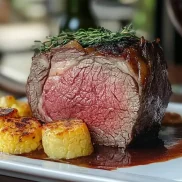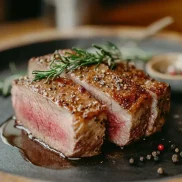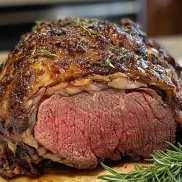Buttermilk pie is a timeless Southern classic, cherished for its creamy, tangy filling and buttery crust. This dessert has stood the test of time, gracing family gatherings, holiday tables, and special celebrations with its delightful blend of flavors and textures. However, as with many beloved recipes, creating the perfect buttermilk pie can present some challenges, especially when it comes to achieving the ideal consistency. A common question that arises in kitchens everywhere is: Why is my buttermilk pie watery?
For those seeking another variation of a classic Southern dessert, explore this delicious Buttermilk Sweet Potato Pie recipe.
Understanding the causes of this issue is the first step toward solving it. Whether you’re a seasoned baker or just starting your culinary journey, knowing the ins and outs of buttermilk pie preparation will help you avoid pitfalls and ensure a perfectly set pie every time. In this article, we’ll dive into the art and science of buttermilk pie, explore its key ingredients, and uncover why texture matters. So, let’s get started on the path to buttermilk pie perfection!
Table of Contents
Understanding the Basics of Buttermilk Pie
To truly master the craft of making buttermilk pie, it’s essential to start with the basics. From its origins to its signature ingredients and the science behind its creamy consistency, let’s break down what makes this dessert so special.
What Is Buttermilk Pie?
Buttermilk pie is a custard-based dessert that’s simple yet utterly satisfying. Its roots trace back to Southern traditions, where families often relied on pantry staples to create delicious treats. This pie is a testament to culinary creativity, transforming everyday ingredients into a rich and flavorful masterpiece.
The filling, made with buttermilk, sugar, eggs, and a hint of flavoring, is poured into a pre-baked or uncooked pie crust and baked until it sets. The result is a golden-brown top with a custardy interior that’s tangy, sweet, and perfectly smooth. The pie’s humble ingredients belie its luxurious taste and texture, making it a favorite across generations.
What sets buttermilk pie apart from similar desserts like chess pie is the tanginess imparted by the buttermilk. This distinct flavor balances the sweetness and adds complexity, elevating the dish from simple to sensational.
Key Ingredients in a Traditional Buttermilk Pie
The beauty of buttermilk pie lies in its simplicity. Let’s take a closer look at the essential ingredients and their roles:
- Buttermilk: The star of the show, buttermilk not only provides the pie’s signature tang but also contributes to its creamy texture. Furthermore, its slight acidity interacts with other ingredients, especially eggs, to create a rich and velvety filling.
- Eggs: Acting as a binding agent, eggs are crucial for setting the custard. They create structure while maintaining the silky smooth consistency that defines buttermilk pie.
- Sugar: This ingredient adds sweetness to balance the tartness of the buttermilk. Granulated sugar is commonly used, but some variations include brown sugar for a deeper flavor.
- Butter: Melted butter adds richness and enhances the overall flavor of the pie. It also helps create a slightly crisp crust on top of the custard.
- Flour or Cornstarch: These dry ingredients are often included in small amounts to stabilize the filling and prevent it from becoming too watery.
- Flavorings: Vanilla extract, lemon juice, or nutmeg can be added to enhance the taste. Each variation brings a unique twist to the classic recipe.
- Pie Crust: A flaky, buttery crust provides the perfect contrast to the creamy filling. Whether homemade or store-bought, the crust is an essential component that completes the dish.
Combining these ingredients carefully results in a perfect balance of flavors and textures that define buttermilk pie.
The Science Behind Buttermilk Pie’s Texture
Achieving the perfect texture in buttermilk pie is both an art and a science. Understanding how the ingredients interact can help you troubleshoot issues like a watery filling and make adjustments for success.
- The Role of Proteins: Eggs are rich in proteins that coagulate when heated. This process sets the custard, giving it structure. However, if the pie isn’t cooked long enough, the proteins don’t fully coagulate, leading to a runny filling.
- The Impact of Acidity: Buttermilk’s acidity is a game-changer. It reacts with other ingredients, particularly baking soda (if included), to create a light and airy texture. The acidity also helps thicken the custard as it bakes.
- Heat and Timing: Baking at the right temperature for the appropriate duration is critical. Too high a temperature can cause the custard to curdle, while too low can leave it undercooked and watery.
- Stabilizing Agents: Ingredients like flour or cornstarch absorb excess moisture, ensuring a firm filling. Without these stabilizers, the custard may not set properly, especially if the buttermilk or eggs contain excess liquid.
- Cooling Process: A buttermilk pie continues to set as it cools. Cutting into it too soon can result in a watery texture, even if it was baked correctly. Allowing the pie to cool completely, preferably for several hours, is essential.
Understanding these scientific principles equips you to create a buttermilk pie that sets perfectly, remains creamy, and tastes irresistibly delicious.
Common Causes of a Watery Buttermilk Pie
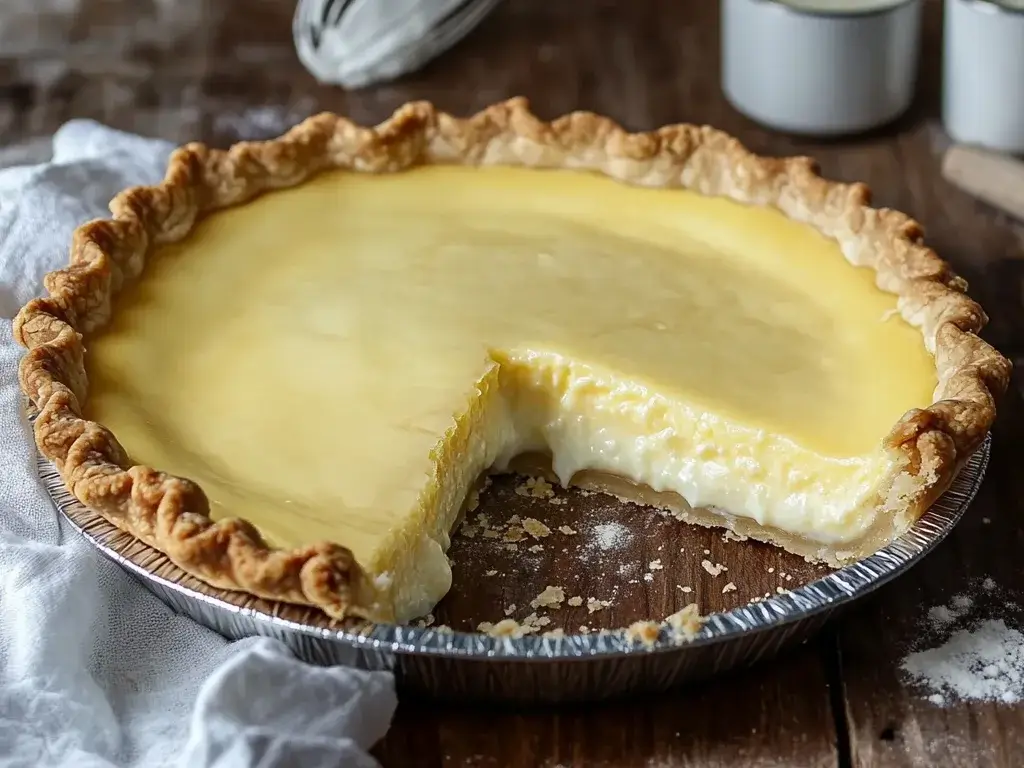
Even with the best intentions, a buttermilk pie can sometimes turn out watery. Understanding the most common causes can help you troubleshoot and avoid this problem in future attempts.
Insufficient Baking Time
One of the most frequent reasons for a watery buttermilk pie is undercooking. Custards rely on precise heat to set properly, and rushing the baking process can leave your pie unset.
- How Undercooking Affects Texture: When the pie isn’t baked long enough, the egg proteins don’t fully coagulate. This means the custard remains in a semi-liquid state, resulting in a watery consistency. A properly baked buttermilk pie should have a slight jiggle in the center but be firm around the edges.
- Solution: Use a thermometer to check the internal temperature of your pie. The custard should reach around 175–180°F (79–82°C). Additionally, ensure your oven is calibrated correctly to avoid temperature inaccuracies.
Improper Ratios of Ingredients
The balance of ingredients is critical to achieving the right texture. An imbalance, particularly too much liquid, can cause the filling to fail.
- Too Much Liquid in the Filling: If the buttermilk or melted butter measurements are off, the filling can become overly runny. This excess liquid overwhelms the thickening agents, preventing the pie from setting.
- The Role of Eggs in Thickening: Eggs act as the primary thickening agent in buttermilk pie. Too few eggs or using smaller eggs than the recipe calls for can result in insufficient structure.
- Solution: Always measure ingredients accurately using a kitchen scale for the best results. Stick to the specified egg size (typically large) to maintain the proper ratio.
Inadequate Cooling Process
Allowing the pie to cool completely is just as important as baking it properly. Cutting into the pie too soon can lead to a watery texture.
- Why Cooling Matters: The custard continues to firm up as it cools. If sliced prematurely, the filling won’t have enough time to set, and liquid may pool around the edges.
- Solution: After baking, let the pie cool at room temperature for at least 2–3 hours. For best results, refrigerate the pie for an additional hour before serving.
Using Low-Quality or Substituted Ingredients
The quality of your ingredients can significantly impact the final texture of your buttermilk pie.
- Low-Quality Ingredients: Using low-fat buttermilk or margarine instead of butter can alter the consistency of the filling. High-fat ingredients provide richness and stability.
- Substitutions: Replacing buttermilk with regular milk or another liquid without proper adjustments can throw off the custard’s balance.
- Solution: Opt for full-fat buttermilk and real butter for the best results. If you must make substitutions, consult a reliable recipe to adjust other ingredients accordingly.
By addressing these common issues, you’ll be on your way to baking a flawless buttermilk pie every time.
Fixing a Watery Buttermilk Pie

If you’ve found yourself with a watery buttermilk pie, don’t worry—all is not lost. With a few strategic adjustments, you can often salvage your pie or ensure the next one turns out perfectly.
Adjusting the Baking Time
Sometimes, all your pie needs is a bit more time in the oven to set properly. Identifying the signs of doneness is key.
- Signs That Your Pie Is Fully Baked: A fully baked buttermilk pie will have a slightly puffed, golden-brown top. The center should still jiggle gently when shaken, but it should not appear wet or liquid. Using an instant-read thermometer can provide extra assurance; the internal temperature should reach 175–180°F (79–82°C).
Solution: If your pie is undercooked, bake it longer in the oven at a slightly lower temperature (around 325°F or 163°C) to prevent burning the crust. Check every 5–10 minutes to ensure it sets properly.
Tweaking Ingredient Ratios
If your pie consistently turns out watery, it might be time to revisit your recipe and adjust the ingredient ratios.
- Correcting Liquid Levels: Double-check the measurements for liquid ingredients like buttermilk, melted butter, and any added flavorings. Reducing the amount of liquid slightly can make a big difference.
- Using Proper Thickeners: Incorporating a small amount of flour, cornstarch, or even an extra egg yolk can help stabilize the custard. These thickeners absorb excess moisture and create a firmer texture. For more detailed guidance, check out this resource on thickening custard pies.
- Solution: Experiment with minor adjustments to the recipe, keeping track of changes to identify what works best for your pie.
Improving the Cooling Process
Cooling your pie properly is crucial for achieving the right texture and ensuring the custard sets perfectly.
- Why Cooling Matters: A properly baked buttermilk pie continues to set as it cools. Cutting into it prematurely releases trapped heat, which can cause the filling to weep and become watery.
- Solution: Allow the pie to cool at room temperature for 2–3 hours. For the best results, transfer it to the refrigerator and let it chill for an additional hour before serving. This ensures the custard has fully set and will hold its shape when sliced.
By making these adjustments, you’ll transform a watery buttermilk pie into a dessert that’s rich, creamy, and perfectly set every time.
Preventing Watery Buttermilk Pie in Future Attempts
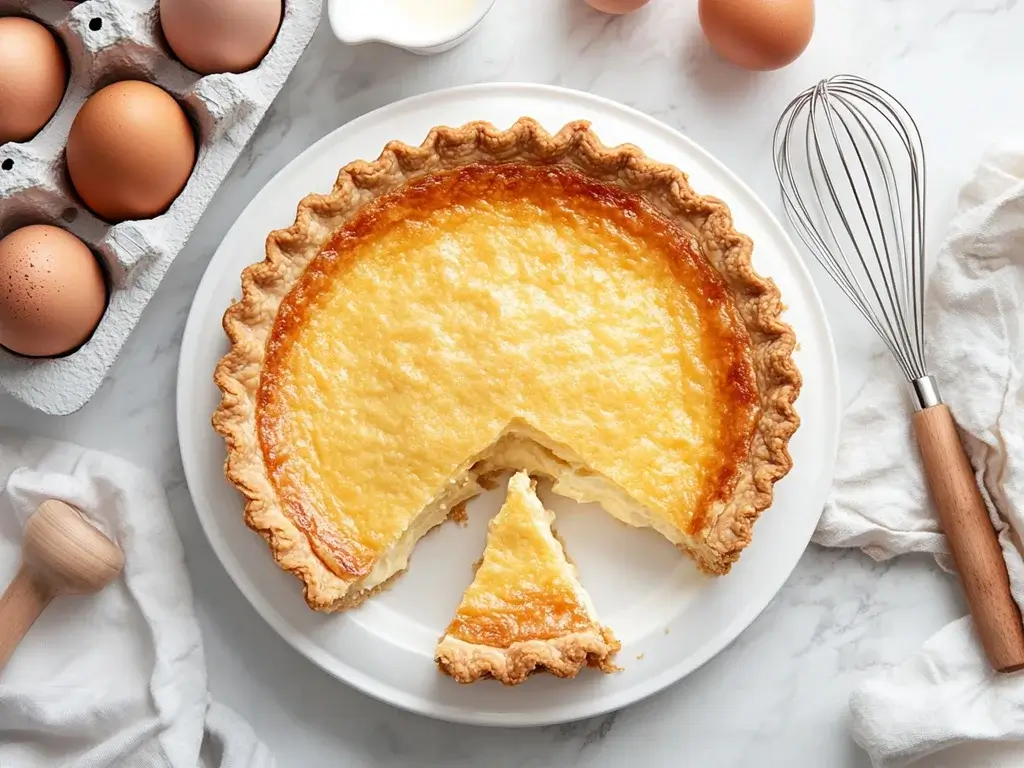
Preventing a watery buttermilk pie requires a proactive approach and thoughtful preparation. By applying a few strategic techniques, you can ensure consistently excellent results in all your future baking efforts.
Selecting High-Quality Ingredients
The foundation of any good recipe is high-quality ingredients. For buttermilk pie, this means choosing ingredients that contribute to the pie’s structure and flavor.
- Buttermilk: Opt for full-fat buttermilk rather than low-fat versions. Full-fat buttermilk provides the necessary creaminess and tang that defines this pie.
- Eggs: Use fresh, large eggs to ensure proper binding. Older eggs or using the wrong size can disrupt the custard’s texture.
- Butter: Stick to unsalted, high-quality butter. Margarine or low-fat substitutes lack the richness needed for the filling.
By selecting top-notch ingredients, you’ll give your pie the best chance to set properly and taste amazing.
Following a Tested Recipe
Sticking to a trusted and well-reviewed recipe is key to consistent results. Avoid making changes unless you’re confident about how they’ll affect the texture.
- Accuracy Matters: Measure ingredients carefully, using a kitchen scale if possible. Precision is especially important for liquid and dry ingredients.
- Timing and Temperature: Follow the recommended baking time and temperature exactly. Use an oven thermometer to ensure your oven is accurate.
By adhering to a proven recipe, you reduce the chances of errors that lead to a watery pie.
Perfecting Baking and Cooling Techniques
Even with the best ingredients and a reliable recipe, your baking technique is critical to achieving a flawless buttermilk pie. Mastering a few key steps can make all the difference in ensuring your pie turns out perfectly.
- Preheat Your Oven Properly: Always preheat your oven to the correct temperature before placing your pie inside. An improperly heated oven can lead to uneven baking and affect the pie’s consistency.
- Mix Ingredients Gently: When combining ingredients, mix just until they are incorporated. Overmixing can introduce air into the custard, causing it to bake unevenly or develop an undesirable texture.
- Use the Right Bakeware: Choose high-quality pie pans to ensure even heat distribution. Glass or ceramic pie dishes work well because they allow the pie to bake evenly and prevent hotspots.
- Monitor Baking Time Closely: Keep a close eye on your pie as it bakes. Custard-based pies like buttermilk pie need precision, so check for doneness by gently shaking the pan to see if the center jiggles slightly while the edges are set.
- Prioritize Cooling Time: Cooling is a crucial step that should never be skipped. After removing your pie from the oven, let it cool completely at room temperature. Cooling allows the custard to set fully, preventing a watery or uneven texture. Once cooled, refrigerate the pie to ensure it holds its shape when sliced.
By mastering these techniques, you can elevate your buttermilk pie from good to exceptional and ensure consistent results every time.
Alternative Variations of Buttermilk Pie
For those with dietary restrictions or looking to try something new, there are several variations of buttermilk pie to explore.
Gluten-Free Buttermilk Pie
For a gluten-free option, substitute the traditional crust with a gluten-free pie crust. Ensure all ingredients, including thickeners like cornstarch, are certified gluten-free.
Vegan and Dairy-Free Options
Creating a vegan or dairy-free buttermilk pie requires some creative substitutions:
- Buttermilk Substitute: Use a mix of non-dairy milk (like almond or soy) and lemon juice or vinegar to mimic the tanginess of buttermilk.
- Egg Replacement: Use flax eggs or a commercial egg replacer for the custard.
- Butter Alternative: Use vegan butter or coconut oil for richness.
These substitutions allow everyone to enjoy the classic flavors of buttermilk pie without compromising dietary preferences.
Flavored Buttermilk Pies
Adding flavors to the traditional recipe is a great way to elevate the dish. Here are two popular variations:
- Lemon Buttermilk Pie: Incorporate fresh lemon juice and zest into the filling for a tangy, citrus twist. This variation is especially refreshing during warmer months.
- Chocolate Buttermilk Pie: Add cocoa powder or melted chocolate to the custard for a rich, decadent version of the classic pie.
By experimenting with flavors, you can create unique versions of buttermilk pie that suit any occasion or palate.
Frequently Asked Questions
Why is my sweet potato pie soggy?
A soggy sweet potato pie is often caused by underbaking the crust or not draining excess moisture from the sweet potatoes. To fix this, pre-bake the crust and ensure the sweet potatoes are properly mashed and drained before making the filling. Learn more
What does buttermilk pie taste like?
Buttermilk pie has a distinct, tangy-sweet flavor with a custard-like texture. The tanginess comes from the buttermilk, which balances the sweetness of the sugar and other flavorings like vanilla or nutmeg. The pie is creamy and smooth, with a slightly caramelized top, making it a delightful mix of rich and light flavors. Learn more
Why does my buttermilk pie crack on top?
Your buttermilk pie cracks on top when it is overbaked or the oven temperature is too high. This causes the custard to set too quickly, leading to cracks as it cools and contracts. Baking the pie at the correct temperature and removing it as soon as the center jiggles slightly can help prevent this issue.
Can I substitute milk for buttermilk in a buttermilk pie?
Yes, you can substitute regular milk by adding an acidic ingredient like vinegar or lemon juice. Combine one cup of milk with one tablespoon of vinegar or lemon juice and let it sit for 5–10 minutes. This creates a buttermilk-like consistency and flavor, though the tanginess may be slightly milder than with traditional buttermilk.
How do I store buttermilk pie?
Buttermilk pie should be stored in the refrigerator to maintain its texture and prevent spoilage. Allow the pie to cool completely, cover it tightly with plastic wrap or aluminum foil, and refrigerate it for up to 4 days. For longer storage, you can freeze it for up to 3 months.
Why is my buttermilk pie watery after refrigeration?
A watery texture after refrigeration usually results from not baking the pie long enough or not letting it cool completely before chilling. The custard needs sufficient time to set during cooling. If your pie is consistently watery after refrigeration, consider baking it for a few extra minutes or adding a stabilizing agent like cornstarch to the filling.
Conclusion
Creating the perfect buttermilk pie requires a combination of knowledge, precision, and patience. From understanding the science behind its creamy texture to troubleshooting common issues like a watery filling, every step plays a vital role in achieving success. By focusing on high-quality ingredients, following tested recipes, and mastering baking and cooling techniques, you can turn this Southern classic into a consistently delightful dessert.
Whether you stick to the traditional recipe or explore creative variations like lemon or chocolate buttermilk pie, the possibilities are endless. Each attempt is an opportunity to refine your skills and enjoy the process of crafting a treat that’s rich in flavor and texture. With these tips and techniques in your arsenal, you’re well on your way to becoming a buttermilk pie expert who can bake with confidence and ease.



